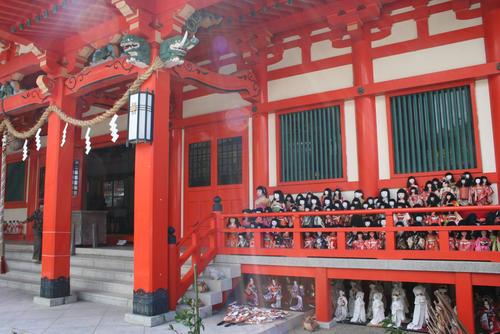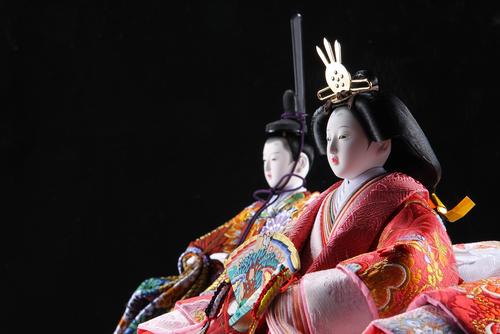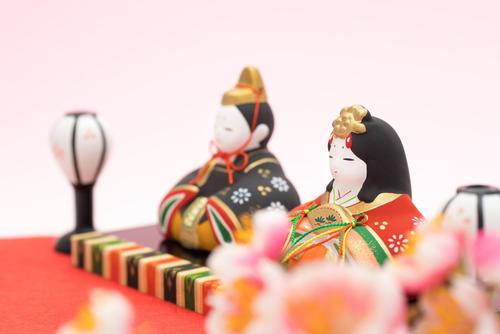History and Customs of Hinamatsuri

First, we will explain the origins of Hinamatsuri, the etymology of the word "hina," and modern-day customs.
The origin of Hinamatsuri
The origin of Hinamatsuri is said to be from an event in the mid-Heian period where people made paper dolls and floated them in the sea or river to purify themselves of impurities.
Even today, customs such as "Nagashibina" still remain in some areas.
The origin of the word "hina"
In Kada, Wakayama City, there is Awashima Shrine, famous for its memorial service for Hina dolls. Awashima Shrine enshrines Sukunahikona no Mikoto as its deity, and is said to grant women the blessing of recovering from illness and safe childbirth. It is said that the "hikona" in "Sukunahikona" is a derivative of the word "hina."
There are also various theories, including that during the Heian period, dolls that girls played with were called "hiina," and that "hiina" was later transformed into "hina."
Modern Hinamatsuri customs
Today, rather than being a time for purification or exorcism, the custom on Hinamatsuri is to display Hina dolls with the hope that girls will grow up healthy and happy. It is common to offer peach blossoms and arrange Hina arare (rice crackers) and hishi mochi (rice cakes with diamonds), and celebratory dinners and parties are sometimes held between March 2nd and 3rd, where dishes such as chirashi sushi, amazake (sweet sake), and clam soup are served.
Displaying Hina dolls represents the parents' desire for their daughter's happiness, as well as the desire to protect women from hardship.
History and evolution of Hina dolls

Hina dolls are a symbol of Hinamatsuri and also serve the role of protecting girls from misfortune. When and how did they become so prevalent in Japanese life? Let's take a look at their origins and history.
The origin of Hina dolls
The origin of Hina dolls is said to be a combination of several events: the Chinese festival of "Joshi-setsu" held in early March; the event of "Nagashibina," in which dolls that take on misfortune and misfortune in place of people are floated down a river; and "Hina-asobi," a type of doll play that was played at the Imperial Court during the Heian period.
Jōshi-setsu is the day of the snake at the beginning of March, and it is said that the practice of warding off evil spirits was introduced to Japan as the seasons changed from winter to spring, and the aristocratic play of "Nagashibina" and playing house evolved into an event where girls are prayed for with Hina dolls.
It was during the Edo period that it changed from something to be thrown away to something to be displayed.
After the Heian period, as the era shifted from samurai society to the Edo period, the Edo Shogunate established five seasonal festivals. Boys' Day on May 5th was celebrated as a time to grow up, and Girls' Day on March 3rd was celebrated as a time to grow up.
During the Edo period, craftsmen also developed doll-making techniques. The dolls used for Hinamatsuri (Girl's Day) became more beautiful and elaborate, and gradually Hina dolls were no longer floated down the river but were treasured and displayed in homes.
Gorgeous Hina dolls were also included as part of a bride's dowry when marrying into a samurai family, and families who could afford expensive Hina dolls were considered to be proof of their wealth, so dolls other than male and female dolls and higher shelves of Hina dolls were added, and the form of Hina dolls that is similar to that of modern Hina dolls was created.
How to arrange the Emperor and Empress dolls
The two essential dolls of Hina dolls, "Ohinasama" and "Otenarisama," are sometimes called "female dolls" and "male dolls," respectively. Currently, the Emperor and Empress dolls are generally arranged with the Emperor on the left and the Empress on the right, but in the traditional style, this was reversed, and even today in some areas, such as Kyoto, the Emperor and Empress dolls are arranged on the right and the Empress on the left.
The difference in the way Hina dolls are arranged between the present and the past dates back to the Showa era. When the Taisho era changed to the Showa era, the enthronement ceremony of Emperor Showa was held, and at this time the Emperor and Empress were lined up in a Western style and photographed.
In the Western style, men are lined up on the left and women on the right, so Tokyo doll makers imitated the arrangement of Emperor Showa and Empress and changed it to the current style.
Why peach blossoms are displayed on Hinamatsuri

Finally, we will explain the origin of Hinamatsuri being called "Peach Festival" and why peach blossoms are displayed on Hinamatsuri.
Peach blossoms were believed to have the power to ward off evil spirits.
Peach blossoms have been popular in Japan for a long time, but they are originally a plant native to China. In ancient China, peaches were believed to have the power to ward off evil spirits and bad luck, and even today, peach-shaped buns are often served at celebratory occasions.
Similarly, in Japan, peaches are considered to be auspicious, and because 100 years old is also called "momotose," they are also seen as a plant that symbolizes longevity.
Since early March in the lunar calendar is the peak time for peach blossoms, Hinamatsuri is known as the "Peach Festival" and people decorate with peach blossoms.
Peach blossoms are also a seasonal word for spring, and their delicate pale pink petals somehow evoke the image of a young girl smiling in the spring. Even today, peach blossoms are a lovely flower that is perfect for decorating for Hinamatsuri.
summary

Hinamatsuri is a celebration held on March 3rd to pray for the happiness and growth of girls. It originated from the Chinese festival of the Siberian Snake, and is derived from the "Nagashibina" dolls, in which dolls are used to ward off misfortunes and then floated down the river, and the "Hina" dolls that girls in the Imperial Court played with during the Heian period.
As the craftsmanship of Hina dolls improved during the Edo period, they began to be displayed in homes, and peach blossoms, which are said to ward off evil spirits, were offered to them. With the upcoming Girls' Festival coming up, why not decorate your home with Hina dolls while thinking about the feelings and wishes of people from long ago?
This article has been partially re-edited by KARUTA from an article originally published on "Nihongo Biyori."
Any unauthorized reproduction or use of the contents, text, images, illustrations, etc. of this website is strictly prohibited.
